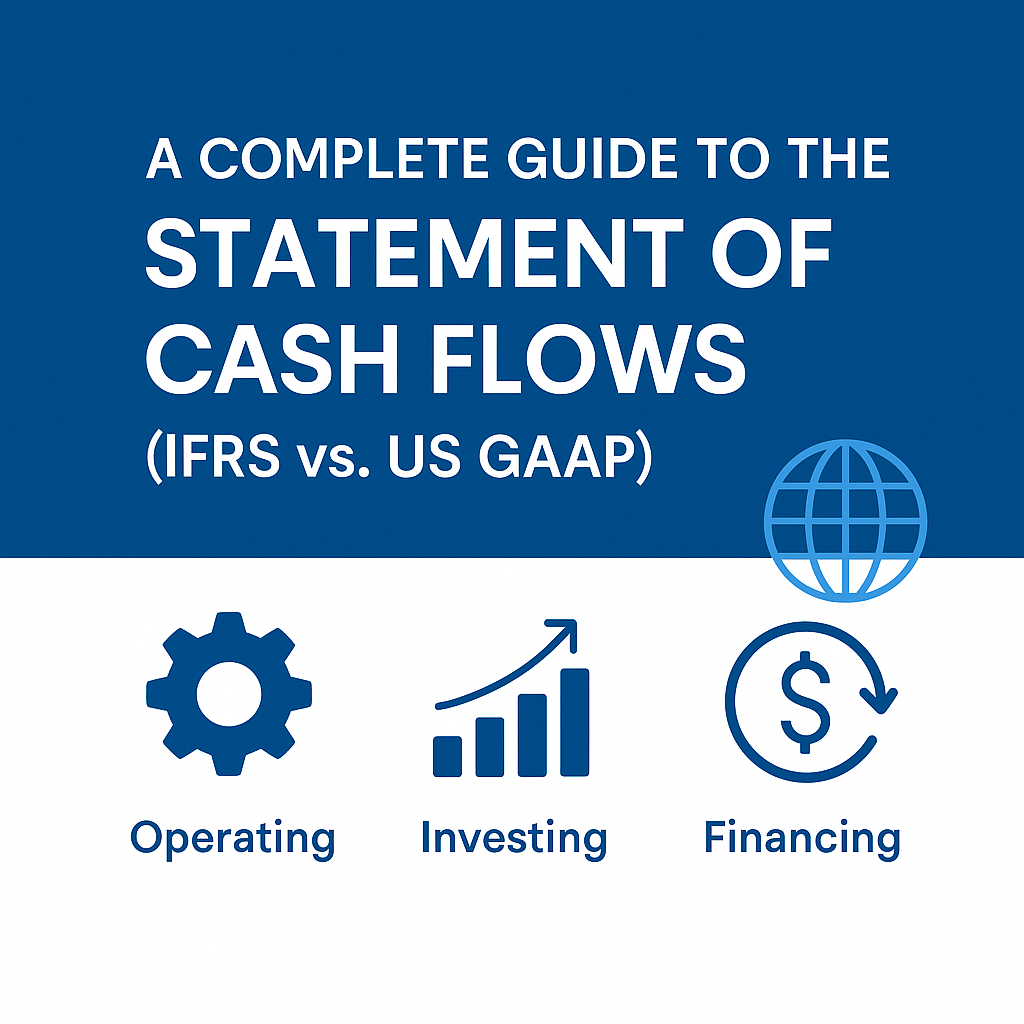
When analyzing a company, many investors tend to focus only on the income statement. However, reported profits often differ significantly from the actual cash generated.
This is why the Statement of Cash Flows is one of the most critical financial reports under both IFRS and US GAAP.
In this article, we will cover:
- What the statement of cash flows is
- How cash and cash equivalents are defined
- The three main categories of cash flows (Operating, Investing, Financing)
- Key differences between IFRS and US GAAP
Definition of Cash and Cash Equivalents
- Cash: currency and demand deposits
- Cash equivalents: short-term, highly liquid investments that are readily convertible to known amounts of cash (e.g., Treasury bills, commercial paper, money market funds), typically with maturities of three months or less
Important note:
- Under IFRS, certain bank overdrafts may be included in cash equivalents.
- Under US GAAP, overdrafts are treated as financing liabilities.
What Is the Statement of Cash Flows?
The Statement of Cash Flows provides information on the inflows and outflows of cash and cash equivalents during a specific accounting period.
Its main purposes are to:
- Evaluate a company’s ability to generate future cash flows
- Assess liquidity and solvency (ability to pay debts and dividends)
- Compare reported net income with actual cash flows
- Provide better comparability across firms and industries
📊 Statement of Cash Flows Template
The Statement of Cash Flows summarizes how a company generates and uses cash during a period. It is divided into Operating Activities, Investing Activities, and Financing Activities.
| Section | Line Item | Amount (USD) | Notes |
|---|---|---|---|
| I. Operating Activities | Net income | Starting point (indirect method) | |
| + Depreciation & amortization | Non-cash expense | ||
| ± Change in inventory | Increase (−), Decrease (+) | ||
| ± Change in accounts receivable | Increase (−), Decrease (+) | ||
| ± Change in accounts payable | Increase (+), Decrease (−) | ||
| Cash received from customers | Inflows from sales | ||
| Cash paid to suppliers | Payments for purchases | ||
| Salaries and wages paid | Employee compensation | ||
| Net Cash from Operating Activities | XXX | ||
| II. Investing Activities | Purchase of property, plant, and equipment (PPE) | Capital expenditure | |
| Proceeds from sale of assets | Asset disposals | ||
| Acquisition of financial assets | Investments in securities | ||
| Proceeds from sale of financial assets | Investment recovery | ||
| Net Cash from Investing Activities | XXX | ||
| III. Financing Activities | Proceeds from borrowings | New debt issued | |
| Repayment of borrowings | Debt repayment | ||
| Proceeds from share issuance | Equity financing | ||
| Dividends paid | Shareholder distributions | ||
| Net Cash from Financing Activities | XXX | ||
| IV. Net Change in Cash & Cash Equivalents | Beginning cash balance | At start of the period | |
| Total net cash flow (I + II + III) | XXX | Period change | |
| Ending cash balance | At end of the period |
Three Categories of Cash Flows
1) Operating Activities
Cash flows from a company’s core business operations.
Examples:
- Cash received from customers
- Cash paid to suppliers and employees
- Interest paid and taxes paid
Under IFRS, interest and dividends may be classified as operating, investing, or financing (depending on the company’s policy). Under US GAAP, interest paid/received and dividends received are always operating, while dividends paid are financing.
2) Investing Activities
Cash flows related to long-term assets and investments.
Examples:
- Purchase of property, plant, and equipment (PP&E) → cash outflow
- Proceeds from sale of investments or fixed assets → cash inflow
- Loans made to other entities → cash outflow
Both IFRS and US GAAP classify these consistently as investing activities.
3) Financing Activities
Cash flows related to raising and repaying capital.
Examples:
- Issuing shares or debt → inflow
- Repayment of borrowings → outflow
- Dividends paid → outflow
Main difference:
- IFRS: dividends paid may be classified as either operating or financing
- US GAAP: dividends paid must be classified as financing
Why It Matters
- Cash vs. Accruals: A company may report net income while having negative cash flow, signaling liquidity issues.
- Investor focus: Healthy firms usually generate positive operating cash flow greater than net income.
- Credit analysis: Lenders rely on cash flow trends to assess repayment capacity.
Summary Table (IFRS vs. US GAAP)
IFRS vs US GAAP: Cash Flow Classification
| Category | IFRS Classification | US GAAP Classification |
|---|---|---|
| Operating CF | Core business activities. Interest/dividends received or paid may be classified as operating, investing, or financing | Core business activities. Interest paid/received and dividends received → operating |
| Investing CF | Purchase/sale of PPE, intangibles, investments | Same as IFRS |
| Financing CF | Issuing shares/debt, loan repayments, dividends paid (choice of operating or financing) | Issuing shares/debt, loan repayments, dividends paid (financing only) |
Key Takeaway
The Statement of Cash Flows is not just another report—it is the “reality check” of financial statements.
While the income statement may show profits, only the cash flow statement reveals whether a company is truly generating cash to sustain growth, repay debt, and reward shareholders.
👉 For investors: always compare net income vs. operating cash flow and pay close attention to financing and investing activities for long-term insights.